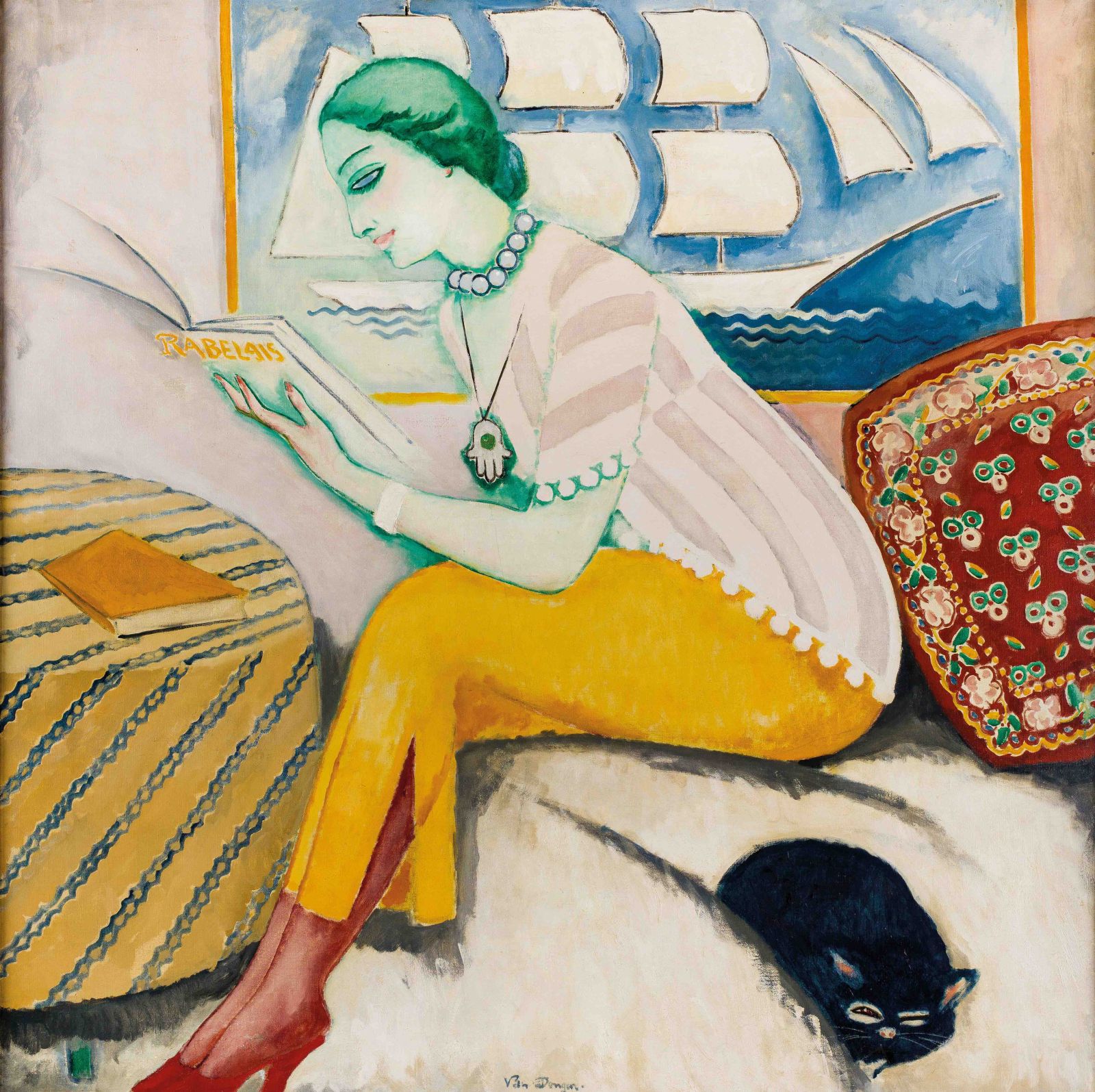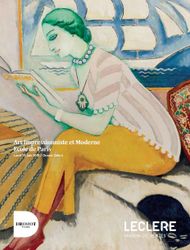LECLERE-MAISON DE VENTES - A major work by Kees Van Dongen for the first time at auction
Monday 25 June 2018 On Monday 25 June, auction house Leclere will offer a painting by Kees VAN DONGEN (1877-1968) entitled The Reading in an impressionist and modern art sale at Drouot. Executed in 1911, this work of art marks the transition between the artist’s fauve and society periods. This masterpiece stands as a tribute to his wife Augusta Preitinger and to his friend Paul Poiret. It was kept in the family of Van Dongen for over 70 years and was then acquired 30 years ago by a Parisian collector. This monumental painting, unprecedented in the art market, is the most important featured at auction in France since 2006.
On Monday 25 June, auction house Leclere will offer a painting by Kees VAN DONGEN (1877-1968) entitled The Reading in an impressionist and modern art sale at Drouot. Executed in 1911, this work of art marks the transition between the artist’s fauve and society periods. This masterpiece stands as a tribute to his wife Augusta Preitinger and to his friend Paul Poiret. It was kept in the family of Van Dongen for over 70 years and was then acquired 30 years ago by a Parisian collector. This monumental painting, unprecedented in the art market, is the most important featured at auction in France since 2006.The Reading or Rabelais can be considered as the first masterpiece following Kees Van Dongen’s fauve period. This 1911 monumental painting (145,5 x 145,5 cm), executed in Paris by the artist when coming back from a trip in Spain and Morocco, reveals both an exotic and a society inspiration. Standing as a turning point into the artist’s career, this work of art prefigures his portraits of the Parisian high society, and also fits into the early 20th century decorative avantgarde.
The composition is organised around Augusta Preitinger’s portrait – his wife from 1901 to 1921 – in an intimate Oriental setting, very dear to the artist. Focused on reading a book by Rabelais, she is seating on a sofa among floral and geometrical patterned cushions and in front of a painting representing a sailboat. At the bottom, a black cat is winking at the viewer looking into this private scene.
The Reading is executed when Van Dongen is at the climax of his art. It epitomises the diversity of his subjects and his discoveries regarding shapes. Searching for recognition as an artist, he is a hard-working painter standing out in every type of avant-garde. Regularly exhibited at the Salon des Indépendants and Salon d’Automne, he meets the famous dealer Kahnweiler. Within a few months he exhibits his work in Munich, Brussels and London. Between 1908 and 1916, Van Dongen signs a contract with Bernheim-Jeune, also Matisse, Bonnard, and Utrillo’s dealer. In June 1911, the gallery offers him a solo exhibition. It is so successful that Bernheim-Jeune renews the exhibition later in December. This collaboration gives him the opportunity to deepen his friendship with Félix Fénéon, famous art critic and artistic director of Bernheim-Jeune. All this energy gives him a way through success along with a more comfortable way of life. His work is soon recognised by a rich clientele who likes to acquire art pieces from Bernheim-Jeune.
VAN DONGEN AND MATISSE: RENEWED ORIENTALISM
The taste for Northern African subjects and patterns, present in 19th century paintings - and particularly in the works by Gros, Ingres and Delacroix and even Renoir – still remains at the beginning of the 20th century. In Germany, expressionists from the group Die Brücke admire Van Dongen’s work. They consider him as a representative of their values in Paris and brightly renew the genre. In France, this new orientalism is undoubtedly led by Matisse and Van Dongen, both featured at the Salon d’Automne in 1905 and represented since 1908 by Bernheim-Jeune.
Whereas Fauvism is almost over, the discovery of Mediterranean countries is the occasion to give a new impulse to his work. After a brief stay in Italy, he goes to Spain, Morocco and Egypt, countries which foster his painting at the beginning of the 1910’s. The resources of Bernheim-Jeune gallery allow the artist to fulfill his interest for Oriental estheticism.
The Reading is a testimony of this metamorphosis: a new interest for decoration is added to his “yellow fever”. His painting is smoother, his features thinner, his colours less bright and the composition is more meditated. It gives elegance and sincerity as well as an increasing attention to the pattern still unprecedented in Van Dongen’s work, providing the esthetical foundations of his new way of painting.
Like Matisse, he refers to the traditional Oriental figuration which implies flat patterns, claiming an art which is openly decorative.
The Turkish-inspiration Chintamani patterns on the cushions evidently reminds us of Matisse’s odalisques from the 1920’s. The decorative pattern carries exoticism and Van Dongen choses to give a certain esthetical archaism, particularly visible in Augusta’s representation. While her face is in profile, her left eye looks directly at us. It recalls the Egyptian sculptures on walls and also, in a more contemporary way, the woman standing left in Picasso’s Demoiselles d’Avignon.
VAN DONGEN AND POIRET’S LIFESTYLE
Unlike Matisse, Van Dongen adapts orientalism to Parisian tastes, recreating, in the The Reading, a highly chic atmosphere.
The Reading captures the society point of view the artist adopts circa 1910. The painting is actually executed close to the time Van Dongen met fashion designer Paul Poiret. At the time, Poiret is already internationally known which has a great influence on the Van Dongen couple. Kees shares his interest for exoticism, Oriental fabric and warm colours, at the time, Augusta often wears Poiret’s creations. In The Reading, an oriental detail is added to her outfit: a hand of Fatma worn as a pendant, a traditional Berber lucky charm, brought back from Morocco by Van Dongen.
Far from the lightness of its pattern, The Reading carries a strong and innovative formal language, true symbol of Matisse and Picasso’s works. Acclaiming the 1910 Parisian chic, this painting celebrates female beauty, the reinterpretation of Oriental exoticism and Paul Poiret’s taste.
Auction - Drouot - Room 4
Monday 25 june - 14h
Exhibition Œuvres Choisies [Classique & Moderne] - Drouot - Room 9
Thursday 24 May - 11PM / 9PM
Friday 25, Saturday 26, Monday 28 and Tuesday 29 May - 11AM / 6PM
Public exhibition – Drouot – Room 4
Saturday 23 June - 11AM / 6PM
Monday 25 June - 11PM / 12AM

Monday 25 june - 14h
Exhibition Œuvres Choisies [Classique & Moderne] - Drouot - Room 9
Thursday 24 May - 11PM / 9PM
Friday 25, Saturday 26, Monday 28 and Tuesday 29 May - 11AM / 6PM
Public exhibition – Drouot – Room 4
Saturday 23 June - 11AM / 6PM
Monday 25 June - 11PM / 12AM


art impressionniste et moderne, école de Paris
Sale Monday 25 June 2018
Salle 4 - Hôtel Drouot - 9, rue Drouot 75009 Paris, FranceAuction house
De Baecque et Associés
Leclere - Maison de ventes
Leclere - Maison de ventes
Tel. 01.58.40.82.92 (Paris) - 04.72.16.29.44 (Lyon) - 04 91 50 00 00 (Marseille)